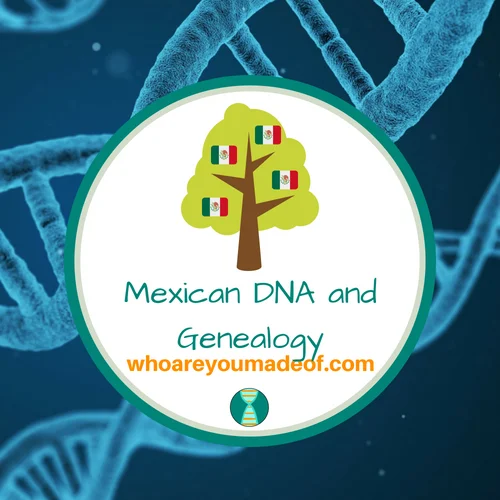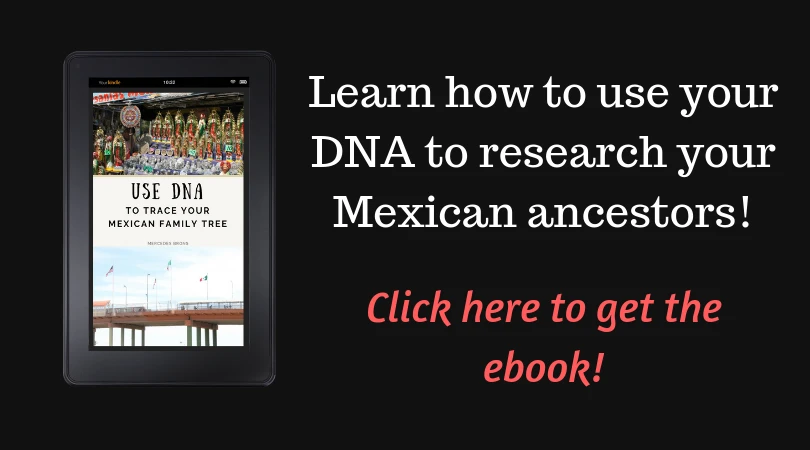If you have Mexican ancestors, you may be wondering what a DNA test can tell you, and whether or not it can help you trace your family tree. In this post, learn what a DNA test can reveal, how it can help you trace your Mexican roots, and even how to find free Mexican family tree records.

What can someone with Mexican roots expect from a DNA test?
A genetic test for ancestry will produce results generally consisting of at least two parts. One part is the ethnicity estimate, and the other consists of your DNA matches.
DNA testing companies are able to determine if someone is related to you by testing SNPs (single nucleotide polymorphisms), or the super tiny genetic variations between humans that make us different from each other.
People who are related are genetically more similar, and scientists are able to estimate your relationship to someone based on how genetically similar you are.
The science behind the testing is crazy complicated, but the process for people like us (those who are interested in taking a DNA test) is pretty simple. We spit in a tube, or do a quick cheek swab, and we can log in to a fancy website and see all of our DNA information presented in an easy-to-understand manner.
Most people become interested in taking a DNA test to learn about their ethnicity. If you have Mexican ancestry, this is the best reason to take a DNA test. With the incredible genetic diversity in Mexico, a result of hundreds of years of migration to the region, you will almost definitely discover something that absolutely fascinates you.
Many people are under the impression that everyone from Mexico has a simple mixture of Iberian (Spanish) and Native American ancestry - in other words, mestizos. In reality, Mexico is the true North American melting pot.
Mexicans can have Asian, African, European and Middle Eastern ethnicity regions show up in their DNA results, along with substantial Native American. Some people from Mexico will be primarily Native American, others will be primarily Spanish, afromestizos will be a beautiful combination of African, Native American, and European DNA, and still others will be Irish, Middle Eastern, Central Asian, or Jewish.
- Do you want to know more about how "Mexican DNA" might show up on a DNA test? Read What do Mexican Ancestry DNA Results Look Like?
Can a DNA test help trace Mexican ancestry?
I love to encourage people who are interested in taking a DNA test to consider using their results to help trace their family tree. Ethnicity estimates, as I mentioned above, can be fascinating and are definitely great for holiday discussions with family.
The real gold in DNA testing, however, is with the DNA matches.
DNA matches are a good source of information about your family's background. They are your family, and part - or all - of their family tree is your family tree, and you can learn from them.
There are many very good techniques for using DNA matches to build your family tree, and I write about many of them on this site. DNA matches are my favorite topic, and I am very passionate about them - in case you can't tell.
How can DNA matches help you trace your Mexican heritage?
- If you are adopted, or don't know much about your close biological family, you might have a close family DNA match who can give you the information you are looking for
- If you find something unexpected on your ethnicity estimate, you may find clues among your DNA matches as to how you may have inherited that ethnicity, since you might have matches with posted family trees who share that ethnicity region with you
- People moved around quite a bit in Mexico, and the family trees of your DNA matches will give you some clues as to the geographic areas where your ancestors lived.
Learn more about using DNA matches to build your family tree.
Where is a good place to build a Mexican family tree?
There are many great websites for building a family tree, and if you already have a favorite, you should definitely stick with what you know. I prefer to use Ancestry to build family trees for a few reasons:
- It's completely free to build as many trees as you want
- You can invite family members to easily view and collaborate with you on your tree
- I recommend DNA testing with Ancestry DNA, and you can connect your tree with your DNA to get additional benefits
- With a subscription, you get access to millions of records and documents - some that are not accessible online through other sites, and others that are not indexed elsewhere
How can I find Mexican genealogy records?
As I mentioned before, Ancestry is a great place to find records and documents, but there are other places that you might be able to find relevant genealogical records as well as historical documents that are helpful to your research.
By far, the most useful free site is the following:
- Familysearch.org (free records - many Mexican records are indexed, but many are not)
Don't forget to ask your older family members for copies of old documents and correspondence. They may have birth, baptismal, and death certificates that may prove very useful to you.
Old correspondence can give you valuable clues to help you know where to search for your ancestors.
Conclusion
I hope that this post gave you some insight as to how DNA testing can help you build a family tree, explore your heritage, and learn some pretty cool family history - especially if you are from Mexico or have Mexican ancestry.
If you have any questions about something that you read here, or would like to share your own experience using DNA with genealogy, I would love to hear from you in the comments.
Thanks for stopping by!

